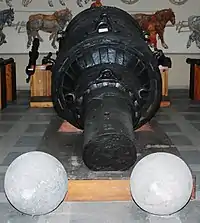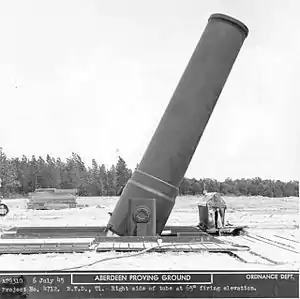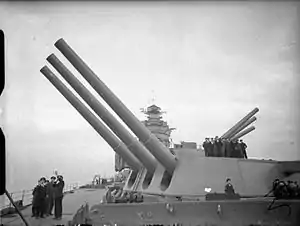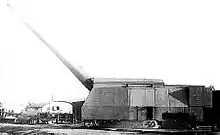
This list contains all types of cannon through the ages listed in decreasing caliber size. For the purpose of this list, the development of large-calibre artillery can be divided into three periods, based on the kind of projectiles used, due to their dissimilar characteristics, and being practically incommensurable in terms of their bore size:
- Stone balls: Cannon of extraordinary bore, which fired stone balls, were first introduced at the turn of the 14th to 15th century in Western Europe. Following a logic of increasing performance through size, they had evolved from small handguns to giant wrought-iron or cast-bronze bombards within a span of just several decades.[1]
- Iron balls and shot: By the 16th century, however, a general switch from stone balls to smaller, but much more effective iron projectiles was in full swing. This and the parallel tendency towards standardized, rapid-firing cannon made the enormously costly and logistically demanding giant guns soon obsolete in the European theatre (with the exception of the odd showpiece).[2]
- Explosive shells: In the Industrial Age, artillery was again revolutionized by the introduction of explosive shells, beginning with the Paixhans guns. Breakthroughs in metallurgy and modes of production were followed up by new experimentation with super-sized caliber weapons, culminating in the steel colossi of the two World Wars. In the post-war era, the development of extremely overpowered artillery was gradually abandoned in favour of missile technology, while heavy guns are still demanded by various arms of the service.
Cannon by caliber
Stone balls
Heyday: 15th to 17th centuries
Iron balls and shot
Heyday: 16th to 19th centuries
| Caliber (mm) | Name | Type | Produced | Place of origin | Made by | |
|---|---|---|---|---|---|---|
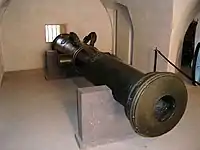 |
280[14] | Kanone Greif | Scharfmetze ("medium size") | 1524 | Electorate of Trier | Master Simon |
 |
280 | Jaivana | 1720 | Jaigarh Fort, Jaipur Riyasat, | ||
 |
286 | Dal Madal Kaman/Dala Mardana | 1565[15][16] | Mallabhum, Malla dynasty | Jagannath Karmakar | |
 |
152 | Jahan Kosha Cannon | 1637[17][18] | Bengal Subah, Mughal Empire | Janardan Karmakar | |
 |
240 | Zamzama | 1757 | Durrani Empire | Shah Nazir | |
 |
508 | Dahlgren smoothbore cannons | 1864 | American Civil War | John A. Dahlgren | |
.jpg.webp) |
508 | Rodman gun | 1864 | American Civil War | Thomas Jackson Rodman | |
Twenty-inch (508 mm) Rodman and Dahlgren smoothbore cannons were cast in 1864 during the American Civil War. The Rodmans were used as seacoast defense. Although not used as intended, two 20-inch Dahlgrens were intended to be mounted in the turrets of USS Dictator and USS Puritan.
Explosive shells
Heyday: 19th to 20th centuries
See also
Notes
- ↑ The bombard has a conical bore of 82.5–90 cm.
- ↑ The bombard has a conical bore of 76–88 cm.
- ↑ Bown[4] indicates a larger bore of 36 in (914 mm), but Hollenback[5] says that Kritoboulos, a contemporary source, indicates a circumference of 12 spans and concludes that in this case the smallest of three possible sizes of span is the correct unit, giving 0.745 m for the bore. Hollenback also notes that granite cannonballs dating from the siege of Constantinople had a diameter of 0.711 and could have been shot from this weapon using a wooden sabot.
- ↑ The bombard has a conical bore of 67–80 cm.
- ↑ The bombard has a conical bore of 45–58 cm.
Footnotes
- ↑ Schmidtchen 1977b, pp. 228–230
- ↑ Schmidtchen 1977a, pp. 153–161
- ↑ Schmidtchen 1977a, p. 162; ball diameter is 20 mm less (p. 171, Fn. 41).
- ↑ Stephen R. Bown (2005). A Most Damnable Invention: Dynamite, Nitrates, and the Making of the Modern World. Penguin Group. ISBN 0-670-04524-1.
- ↑ George M. Hollenback (2002), "Notes on the Design and Construction of Urban's Giant Bombard", Byzantine and Modern Greek Studies, 26 (1): 284–291, doi:10.1179/030701302806932231, S2CID 161056159
- ↑ Schmidtchen 1977b, p. 222; ball diameter is 20 mm less (p. 171, Fn. 41).
- ↑ Schmidtchen 1977a, p. 164; ball diameter is 20 mm less (p. 171, Fn. 41).
- ↑ Royal Armouries Archived 2011-08-05 at the Wayback Machine
- ↑ E. Rocchi, Le artiglierie italiane nel Rinascimento, Rome, 1899
- ↑ L. Beltrami, La Galeazesca Vittoriosa, Milan, 1916
- ↑ Schmidtchen 1977b, p. 218; ball diameter is 20 mm less (p. 171, Fn. 41).
- ↑ Schmidtchen 1977a, p. 166; ball diameter is 20 mm less (p. 171, Fn. 41).
- ↑ Schmidtchen 1977b, p. 236, Fn. 103
- ↑ Archiv für die Officiere der Königlich Preußischen Artillerie- und Ingenieur-Korps, Vol. 19, Berlin, Posen, Bromberg 1846, p. 101
- ↑ Dasgupta, Biswas & Mallik 2009, p. 55.
- ↑ "ASI, Kolkata Circle".
- ↑ Journal of the Asiatic Society of Bangladesh: Humanities, Volumes 36-38 Asiatic Society of Bangladesh, 1991
- ↑ The Land of the rupee Bennett, Coleman, 1912, the University of Michigan
- ↑ Meyers Großes Konversations-Lexikon, Vol. 14, Leipzig 1908, p. 160: "Mörser": caliber of 61 cm
- ↑ Journal des Sciences Militaires, 2nd series, Vol. 22, Paris 1838: caliber of 22 pouces = 59,6 cm (p. 49); outer diameter of the barrel: 1 m (p. 54)
References
- Schmidtchen, Volker (1977a), "Riesengeschütze des 15. Jahrhunderts. Technische Höchstleistungen ihrer Zeit", Technikgeschichte, 44 (2): 153–173
- Schmidtchen, Volker (1977b), "Riesengeschütze des 15. Jahrhunderts. Technische Höchstleistungen ihrer Zeit", Technikgeschichte, 44 (3): 213–237
- Dasgupta, Gautam Kumar; Biswas, Samira; Mallik, Rabiranjan (2009), Heritage Tourism: An Anthropological Journey to Bishnupur, A Mittal Publication, p. 55, ISBN 978-8183242943
This article is issued from Wikipedia. The text is licensed under Creative Commons - Attribution - Sharealike. Additional terms may apply for the media files.

